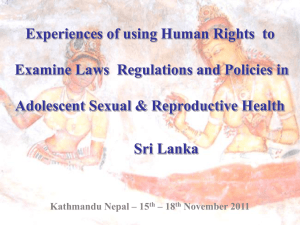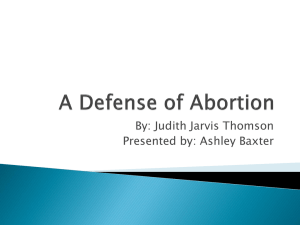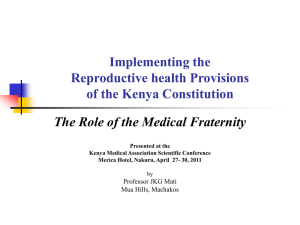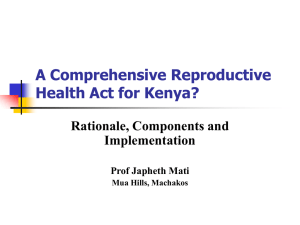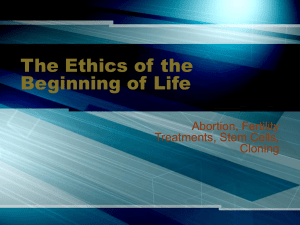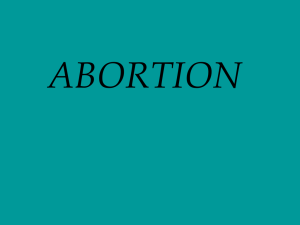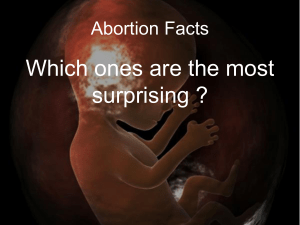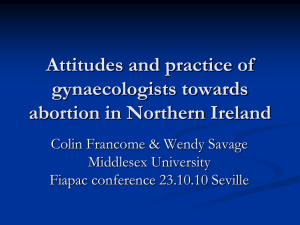Implications of Kenya`s New Constitution to Health Care Programming
advertisement
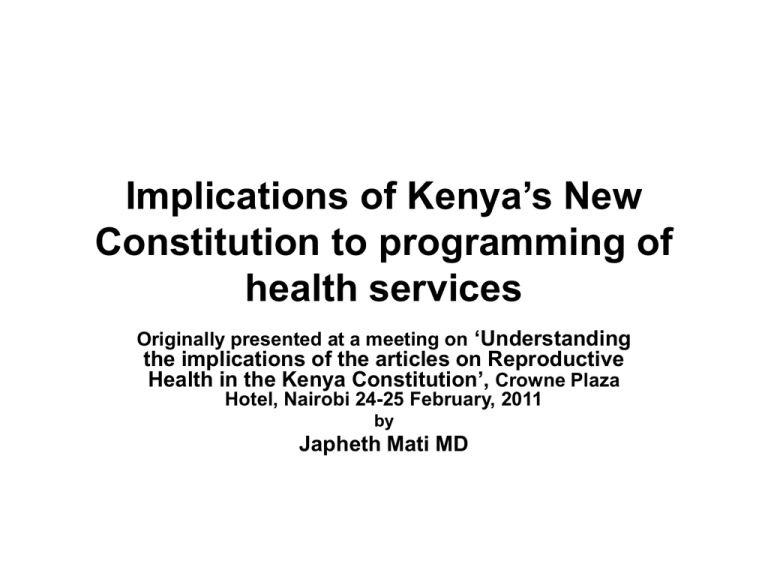
Implications of Kenya’s New Constitution to programming of health services Originally presented at a meeting on ‘Understanding the implications of the articles on Reproductive Health in the Kenya Constitution’, Crowne Plaza Hotel, Nairobi 24-25 February, 2011 by Japheth Mati MD Overview • The presentation seeks to contribute to a factual understanding of health related provisions in the New Constitution, and opportunities created for enhancing health care provision • It seeks to identify opportunities for implementation of these provisions in the health sector, specifically in plans and interventions for the benefit of all in need of health services. • Overall, health providers need to identify opportunities that may emerge from the Constitution, for enhancement of health (including RH) services. Right to Health The Constitution of Kenya captures the concept of ‘health as a human right’ in Art 43 (1) The concept of health as a human righthistorical background • World Health Organisation’s Charter (1946) Preamble: Health is a fundamental right of every human being without distinction of any kind. • The Universal Declaration of Human Rights (1948) Art 25: Everyone has the right to a standard of living adequate for health and well-being of himself and his family. • International Covenant on Economic, Social and Cultural Rights (1966) Art 12: the right of everyone to the enjoyment of the highest attainable standard of physical and mental health. The concept of health as a human righthistorical background Cont’d • The Declaration of Alma Ata (WHO, 1978) • The Program of Action of the International Conference on Population and Development (ICPD) (Cairo, 1994): • The Platform of Action of the Fourth World Conference on Women (Beijing, 1995): • The International Convention on the Elimination of All Forms of Racial Discrimination (1965), Art 11 • The Convention on the Elimination of All Forms of Discrimination against Women (1979) Art 12 • The Convention on the Rights of the Child (1989) Art 24 The recurrent message Everyone has the right to a standard of living adequate for attainment of the highest level of physical and mental health Provisions in Art 43 (1) of the Constitution of Kenya Every person has the right— (a) to the highest attainable standard of health, which includes the right to health care services, including reproductive health care; (b) to accessible and adequate housing, and to reasonable standards of sanitation; (c) to be free from hunger, and to have adequate food of acceptable quality; (d) to clean and safe water in adequate quantities; (e) to social security; and (f) to education. Other guarantees in the Constitution that are relevant to health care In addition to Article 43 (1) (a), the Constitution also guarantees: • To nurture and protect well-being of all (Preamble). • Implementation of international/regional conventions and commitments (Art. 2 (6)) • Respect and protection of dignity for every person (Article 28) • Equality and freedom from discrimination (Article 27) • Emergency medical treatment (Article 43 (2)) Implications of Article 43 (1) to health care programming • Not only is health care (including RH care) a right, access to quality health services becomes a right • Not only is access to adequate housing and reasonable standards of sanitation a right, access to a healthy environment becomes a right • Not only is access to food a right, everyone has a right to good nutrition • Social security is a right; can social health insurance also be considered a right? Equity in health care programming • The Right to Equality and freedom from discrimination (Art. 27) encompasses within itself the right of the poor and marginalised persons to adequate/quality health care regardless of their ability to pay. Right to life Article 26 Article 26: (1) Every person has the right to life. (2) The life of a person begins at conception. (3) A person shall not be deprived of life intentionally, except to the extent authorised by this Constitution or other written law. (4) Abortion is not permitted unless, in the opinion of a trained health professional, there is need for emergency treatment, or the life or health of the mother is in danger, or if permitted by any other written law. Remember the Big Debate in the run up to the Referendum, especially around sub-Articles 26 (2) and (4). On The Big Debate ‘NEW ABORTION LAW IS STILL BAD FOR WOMEN Whichever way the referendum will go, abortion may still be the only birth control option available since many [women] lack access to contraception’ Japheth Mati in STAR Thursday 29 April 2010 Article 26 (4) • “Abortion is not permitted unless, in the opinion of a trained health professional, there is need for emergency treatment, or the life or health of the mother is in danger, or if permitted by any other written law”. Arising from Art.26(4), abortion may be granted if: • (a) There is need for emergency treatment, or • (b) Life or health of the mother is in danger. Note: • (i): (a) and (b) mean the same- emergency treatment always implies danger to life or health! • (ii): Recognition of “life OR health” as ground for abortion is an advantage over what exists in Section 240 of Penal Code- “life” only. • (iii): MPDB Code of Professional Conduct and Discipline considers “health of the mother or baby” (legal basis?) A number of questions arise from Art 26(4) 1. Who is a trained health professional? 2. At what stage is emergency treatment a must? 3. What constitutes danger to life of the mother? 4. What constitutes danger to health of the mother? Questions arising from Art 26(4) (Cont’d) 5. Is there any emergency that does not threaten life or health of the mother? 6. What definition of ‘health’ is implied here? (NB: WHO definition of health includes mental and social wellbeing) 7. 8. Is there a need for a list of conditions (or situations) that may necessitate emergency treatment? etc. Questions arising from Art 26(4) (Cont’d) Note: • Lists may provide examples of conditions that are considered life-threatening, but must not preclude a doctor’s clinical judgment. • There is risk of Lists being interpreted restrictively, or be considered exhaustive, when in fact they cannot be. Who among these is a “trained health professional”? Obstetrician Gynaecologist? Registered medical practitioner? Registered Clinical Officer? Registered Nurse? Registered Midwife? Any health worker trained to competency? All of the above? (None of the above?) MPDB guidelines on abortion • “…. it is strongly advised that the practitioner consults with at least two senior and experienced colleagues, obtains their opinion in writing and performs the operation openly in hospital if he considers himself competent to do so in the absence of a Gynaecologist”. Note: • (i) MPDB does not restrict performance of TOP to gynaecologists only. • (ii) One of the two colleagues is often a psychiatrist- requested to establish risk to life of the woman These MPDB guidelines may obstruct rather than facilitate access to safe abortion services: • Consulting at least two senior and experienced colleagues- how possible in rural areas? • Restricting performance of abortion procedures to hospital- TOP often an OP procedure; not always surgical! • Psychiatric assessment- people resent psychiatric label; expensive, unnecessary delay, and invasion of dignity (Art 28) Providing safe abortion services within the law • ‘Safe abortion’ services are those provided by trained health workers using proper equipment and correct techniques, and supported by policies, regulations and a functional health infrastructure, including equipment and supplies (WHO). • Performed under these conditions TOP is a safe medical procedure • “Unsafe abortion” implies abortion performed outside of above conditions. A time for a paradigm shift? • In order to minimize the problem of ‘unsafe abortion’ and its impacts there is an urgent need for a paradigm shift in strategic emphasis (at all levels), from the present day focus on ‘post-abortion care’ to provision of ‘safe abortion services, within the law’. • This is an opportunity provided for in Art 26 (4). Women are often denied safe abortion services within the law: • Provider related factors: o Lack of knowledge of the law, or failure to apply the law, by providers o Lack of adequately trained providers o Negative provider attitudes, biases and conscientious objection o Lack of awareness (or neglect) among providers of their ethical/legal obligations to provide women in need with appropriate information on where safe abortion services can be obtained. Women are often denied safe abortion services within the law (cont’d) • Medical policies and practices: o Insistence on unnecessary/outdated techniques e.g. hospitalization, use of GA o Opposition to task-shifting, and other regulatory bottlenecks • Community related factors: o Lack of public information about the law o Lack of awareness about facilities providing abortion services o Lack of awareness (among women) of need to report early in pregnancy Conclusions 1. There are opportunities in the Constitution of Kenya for enhancing health in general, including reproductive health and rights of Kenyan women, despite the restrictive stance on abortion. 2. Health care providers must familiarise themselves with these Constitutional provisions for effective implementation of safe abortion services, and for avoidance of unwarranted access barriers to what should be legally accessed by women in need. ...Conclusion 3. 4. The relevant regulatory authorities and professional bodies have a responsibility to ensure their members are updated on the provisions in the Constitution regarding health care including reproductive health care. The government has a responsibility to ensure safe abortion services are equitably accessed by all women in need, by promoting positive policies which eliminate unnecessary access barriers to abortion services within the law.

